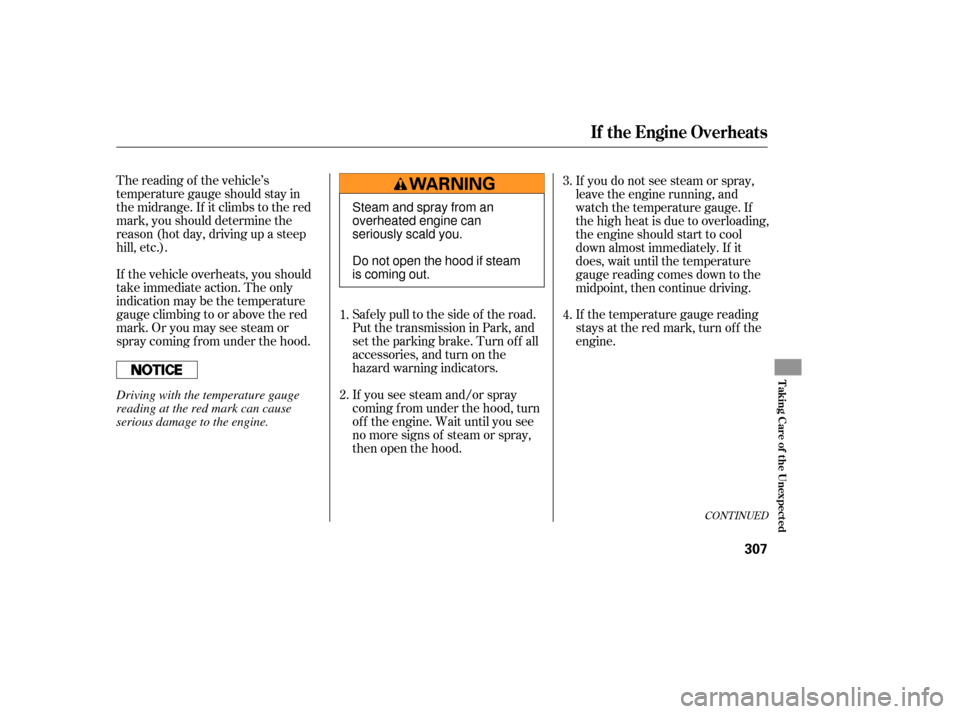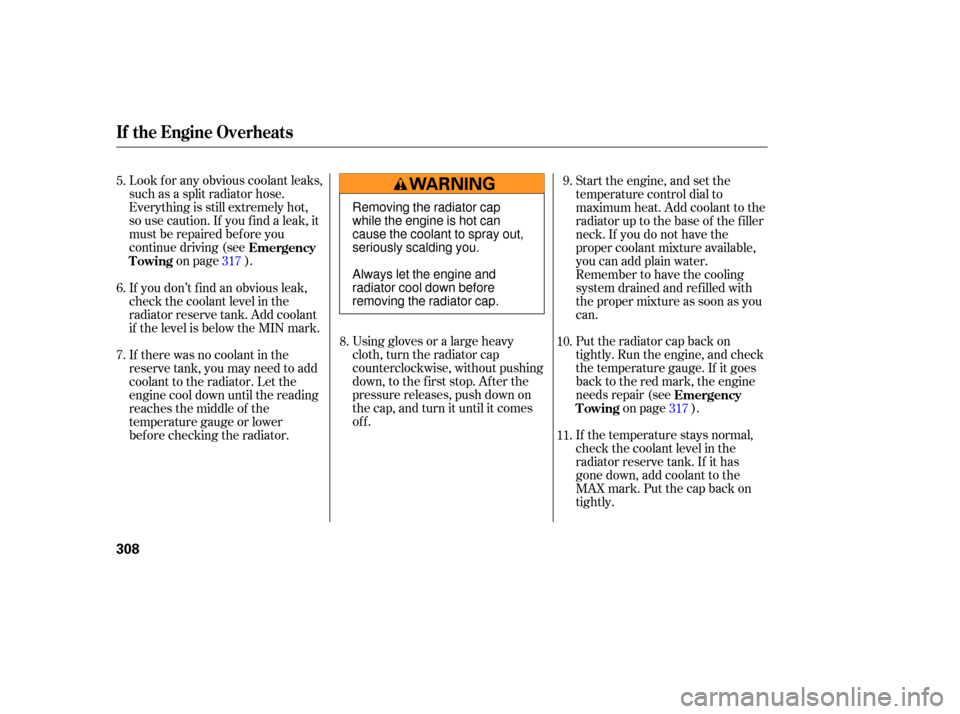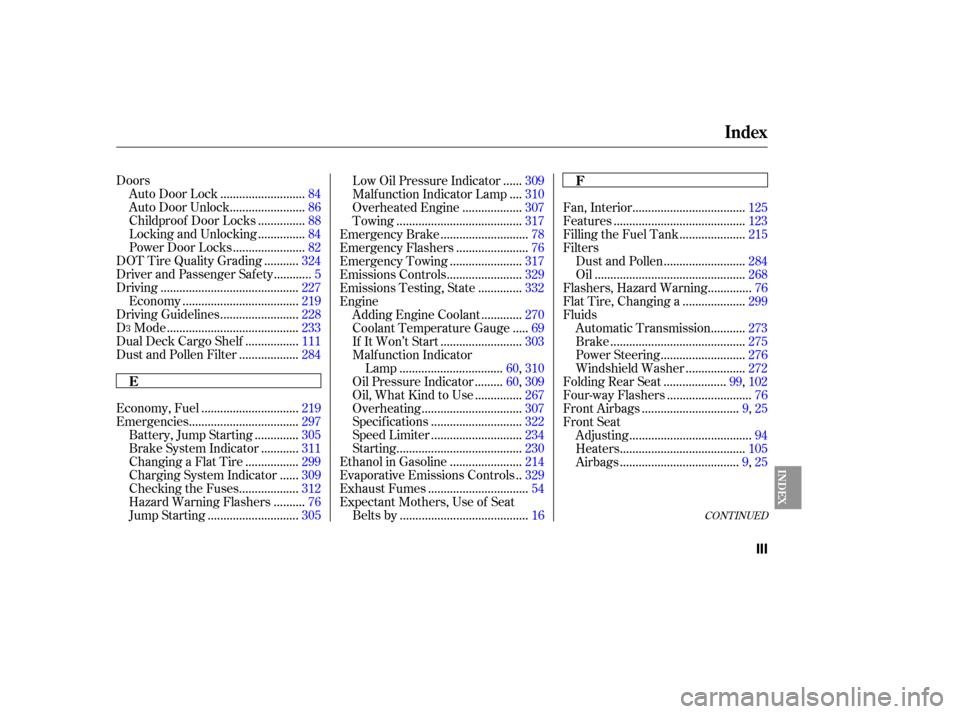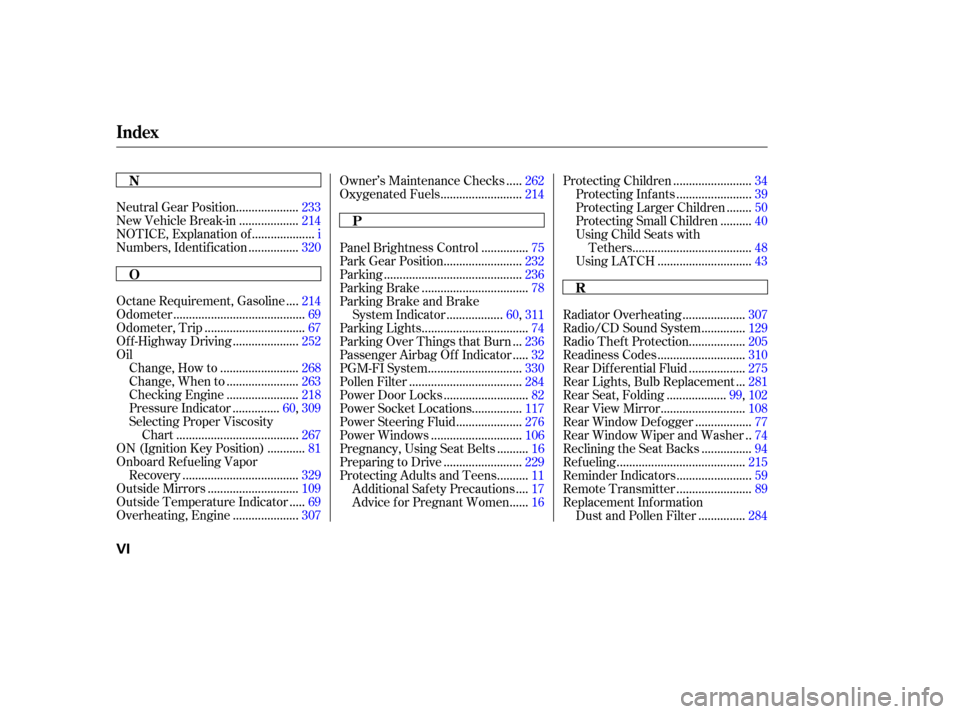engine overheat HONDA CR-V 2007 RD1-RD5, RE7 / 3.G Owners Manual
[x] Cancel search | Manufacturer: HONDA, Model Year: 2007, Model line: CR-V, Model: HONDA CR-V 2007 RD1-RD5, RE7 / 3.GPages: 352, PDF Size: 5.77 MB
Page 246 of 352

Your vehicle is equipped with a tire
pressure monitoring system (TPMS)
that turns on every time you start the
engine and monitors the pressure in
your tires while driving.Driving on a signif icantly under-
inf lated tire causes the tire to
overheat and can lead to tire failure.
Under-inf lation also reduces f uel
efficiency and tire tread life, and may
af f ect the vehicle’s handling and
stopping ability.
Becausetirepressurevariesby
temperature and other conditions,
the low tire pressure indicator may
come on unexpectedly.
When the low tire pressure indicator
is on, one or more of your tires is
signif icantly underinf lated. You
should stop and check your tires as
soon as possible, and inf late them to
the proper pressure as indicated on
the vehicle’s tire inf ormation placard.
If you think you can saf ely drive a
short distance to a service station,
proceed slowly, and inf late the tire to
the recommended pressure shown
on the driver’s doorjamb.
If the tire is f lat, or if the tire
pressure is too low to continue
driving, replace the tire with the
compact spare tire.
If you cannot make the low tire
pressure indicator go out af ter
inf lating the tires to the specif ied
values, have your dealer check the
system as soon as possible. Each tire has its own pressure
sensor (not including the spare tire).
If the air pressure of a tire becomes
signif icantly low, the sensor in that
tire immediately sends a signal that
causes the low tire pressure
indicator to come on.
Tire Pressure Monitoring System (TPMS)
Low Tire Pressure
Indicator
242
Page 253 of 352

Crosswinds and air turbulence
caused by passing trucks can disrupt
your steering and cause the trailer to
sway. When being passed by a large
vehicle, keep a constant speed, and
steer straight ahead. Do not try to
make quick steering or braking
corrections. If youmuststopwhenfacinguphill,
use the f oot brake or parking brake.
Do not try to hold the vehicle in
place by pressing on the accelerator,
as this can cause the automatic
transmission to overheat. When driving down hills, reduce
your speed and use the D3 position.
Do not ‘‘ride’’ the brakes, and
remember it will take longer to slow
downandstopwhentowingatrailer.
When climbing hills, closely watch
your temperature gauge. If it nears
the red (Hot) mark, turn the air conditioning of f , reduce speed and, if
necessary, pull to the side of the
road to let the engine cool.
Maketurnsmoreslowlyandwider
than normal. The trailer tracks a
smaller arc than your vehicle, and it
canhitorrunoversomethingthe
vehicle misses. Allow more time and
distance f or braking. Do not brake or
turn suddenly as this could cause the
trailer to jackknif e or turn over. Drive slower than normal in all
driving situations, and obey posted
speed limits f or vehicles with trailers.
Use the D position when towing a
trailer on level roads. D is the
proper shif t lever position to use
when towing a trailer in hilly terrain.
(See ‘‘ ’’ in the
f ollowing column f or additional gear
inf ormation.)
The lights and brakes on your
vehicle and the trailer are working
properly.
Your vehicle tires and spare are
properly inf lated, and the trailer
tires and spare are inflated as
recommended by the trailer
maker.
The added weight, length, and
height of a trailer will af f ect your
vehicle’s handling and perf ormance,
so driving with a trailer requires
some special driving skills and
techniques.
Foryoursafetyandthesafetyof
others,taketimetopracticedriving
maneuvers bef ore heading f or the
open road, and f ollow the guidelines
in this section.
3
Towing a Trailer
Handling Crosswinds and Buf f et ing
Driving on Hills
Making T urns and Braking
Driving on Hills
T owing Speeds and Gears
Driving Saf ely With a T railerDriving
249
Page 301 of 352

This section covers the more
common problems that motorists
experience with their vehicles. It
gives you inf ormation about how to
safely evaluate the problem and what
to do to correct it. If the problem has
stranded you on the side of the road,
you may be able to get going again.
If not, you will also f ind instructions
on getting your vehicle towed.......................
Compact Spare Tire .298
....................
Changing a Flat Tire .299
.............
If the Engine Won’t Start .303
................................
Jump Starting .305
..............
If the Engine Overheats .307
.........
Low Oil Pressure Indicator .309
..........
Charging System Indicator .309
.......
Malf unction Indicator Lamp .310
...............
Brake System Indicator .311
..............................................
Fuses .312
..............................
Fuse Locations .315
......................
Emergency Towing .317
Taking Care of the Unexpected
T aking Care of t he Unexpect ed
297
Page 311 of 352

CONT INUED
If the vehicle overheats, you should
take immediate action. The only
indication may be the temperature
gauge climbing to or above the red
mark. Or you may see steam or
spray coming f rom under the hood. The reading of the vehicle’s
temperature gauge should stay in
the midrange. If it climbs to the red
mark, you should determine the
reason (hot day, driving up a steep
hill, etc.).Saf ely pull to the side of the road.
Put the transmission in Park, and
set the parking brake. Turn of f all
accessories, and turn on the
hazard warning indicators.If you do not see steam or spray,
leave the engine running, and
watch the temperature gauge. If
the high heat is due to overloading,
the engine should start to cool
down almost immediately. If it
does, wait until the temperature
gauge reading comes down to the
midpoint, then continue driving.
If the temperature gauge reading
stays at the red mark, turn off the
engine.
If you see steam and/or spray
coming f rom under the hood, turn
of f the engine. Wait until you see
no more signs of steam or spray,
then open the hood.
1.
2. 3.
4.
If theEngineOverheats
T aking Care of t he Unexpect ed
307
Steam and spray from an
overheated engine can
seriously scald you.
Do not open the hood if steam
is coming out.
Driving with the temperature gauge
reading at the red mark can cause
serious damage to the engine.
Page 312 of 352

Look for any obvious coolant leaks,
such as a split radiator hose.
Everything is still extremely hot,
so use caution. If you find a leak, it
must be repaired before you
continue driving (see
on page ).
Using gloves or a large heavy
cloth, turn the radiator cap
counterclockwise, without pushing
down, to the first stop. After the
pressure releases, push down on
the cap, and turn it until it comes
off. Put
the radiator cap back on
tightl y. Run the engine, and check
the temperatu re gauge. If it goes
back to the red mark, the engine
needs repair (see on page ).
If the temperature stays normal,
check the coolant level in the
radiator reserve tank. If it has
gone down, add coolant to the
MAX mark. Put the cap back on
tightly. Start the engine, and set the
temperature control dial to
maximum heat. Add coolant to the
radiator up to the base of the f iller
neck. If you do not have the
proper coolant mixture available,
you can add plain water.
Remember to have the cooling
system drained and ref illed with
the proper mixture as soon as you
can.
If you don’t f ind an obvious leak,
check the coolant level in the
radiator reserve tank. Add coolant
if the level is below the MIN mark.
If there was no coolant in the
reserve tank, you may need to add
coolant to the radiator. Let the
engine cool down until the reading
reaches the middle of the
temperature gauge or lower
bef ore checking the radiator. 9.
8.
7. 6. 5.
10.
11.
317
317
Emergency
Towing
Emergency
Towing
If theEngineOverheats
308
Removing the radiator cap
while the engine is hot can
cause the coolant to spray out,
seriously scalding you.
Always let the engine and
radiator cool down before
removing the radiator cap.
Page 345 of 352

CONT INUED
Doors..........................
Auto Door Lock .84
.......................
Auto Door Unlock .86
..............
Childproof Door Locks .88
..............
Locking and Unlocking .84
......................
Power Door Locks .82
..........
DOT Tire Quality Grading .324
...........
Driver and Passenger Safety. 5
...........................................
Driving .227
....................................
Economy .219
........................
Driving Guidelines .228
.........................................
D Mode .233
................
Dual Deck Cargo Shelf .111
..................
Dust and Pollen Filter .284
..............................
Economy, Fuel .219
..................................
Emergencies .297
.............
Battery, Jump Starting .305
...........
Brake System Indicator .311
................
Changing a Flat Tire .299
.....
Charging System Indicator .309
..................
Checking the Fuses .312
.........
Hazard Warning Flashers . 76
............................
Jump Starting .305 .....
Low Oil Pressure Indicator .309
...
Malf unction Indicator Lamp .310
..................
Overheated Engine .307
.......................................
Towing .317
...........................
Emergency Brake .78
......................
Emergency Flashers .76
......................
Emergency Towing .317
.......................
Emissions Controls .329
.............
Emissions Testing, State .332
Engine
............
Adding Engine Coolant .270
....
Coolant Temperature Gauge .69
.........................
If It Won’t Start .303
Malf unction Indicator
................................
Lamp . 60, 310
........
Oil Pressure Indicator . 60, 309
..............
Oil, What Kind to Use . 267
...............................
Overheating .307
............................
Specif ications .322
............................
Speed Limiter .234
.......................................
Starting .230
......................
Ethanol in Gasoline .214
.
Evaporative Emissions Controls . 329
...............................
Exhaust Fumes .54
Expectant Mothers, Use of Seat ........................................
Belts by .16 ...................................
Fan, Interior .125
.........................................
Features .123
....................
Filling the Fuel Tank . 215
Filters .........................
Dust and Pollen .284
...............................................
Oil .268
.............
Flashers, Hazard Warning . 76
...................
Flat Tire, Changing a . 299
Fluids ..........
Automatic Transmission . 273
..........................................
Brake .275
..........................
Power Steering .276
..................
Windshield Washer . 272
...................
Folding Rear Seat . 99, 102
..........................
Four-way Flashers .76
..............................
Front Airbags . 9, 25
Front Seat ......................................
Adjusting .94
.......................................
Heaters .105
.....................................
Airbags . 9, 25
3
Index
E F
INDEX
III
Page 348 of 352

...................
Neutral Gear Position .233
..................
New Vehicle Break-in .214
...................
NOTICE, Explanation of .i
...............
Numbers, Identif ication .320
...
Octane Requirement, Gasoline .214
.........................................
Odometer .69
...............................
Odometer, Trip .67
....................
Of f -Highway Driving .252
Oil
........................
Change, How to .268
......................
Change, When to .263
......................
Checking Engine .218
..............
Pressure Indicator . 60, 309
Selecting Proper Viscosity ......................................
Chart .267
...........
ON (Ignition Key Position) .81
Onboard Ref ueling Vapor
....................................
Recovery .329
............................
Outside Mirrors .109
....
Outside Temperature Indicator .69
....................
Overheating, Engine .307 ....
Owner’s Maintenance Checks .262
.........................
Oxygenated Fuels .214
..............
Panel Brightness Control .75
........................
Park Gear Position .232
...........................................
Parking .236
.................................
Parking Brake .78
Parking Brake and Brake .................
System Indicator . 60, 311
.................................
Parking Lights .74
..
Parking Over Things that Burn . 236
....
Passenger Airbag Of f Indicator . 32
.............................
PGM-FI System .330
...................................
Pollen Filter .284
..........................
Power Door Locks .82
...............
Power Socket Locations . 117
....................
Power Steering Fluid . 276
............................
Power Windows .106
.........
Pregnancy, Using Seat Belts . 16
........................
Preparing to Drive .229
.........
Protecting Adults and Teens . 11
...
Additional Safety Precautions . 17
.....
Advice f or Pregnant Women . 16........................
Protecting Children .34
.......................
Protecting Inf ants .39
.......
Protecting Larger Children . 50
.........
Protecting Small Children . 40
Using Child Seats with .....................................
Tethers .48
.............................
Using LATCH .43
...................
Radiator Overheating . 307
.............
Radio/CD Sound System . 129
.................
Radio Thef t Protection . 205
...........................
Readiness Codes .310
.................
Rear Dif f erential Fluid . 275
..
Rear Lights, Bulb Replacement . 281
..................
Rear Seat, Folding . 99,102
..........................
Rear View Mirror .108
.................
Rear Window Def ogger . 77
.
Rear Window Wiper and Washer . 74
...............
Reclining the Seat Backs . 94
........................................
Ref ueling .215
.......................
Reminder Indicators .59
.......................
Remote Transmitter .89
Replacement Inf ormation ..............
Dust and Pollen Filter . 284
Index
O
R
P
N
VI